
A defensive wall is a fortification usually used to protect a city, town or other settlement from potential aggressors. The walls can range from simple palisades or earthworks to extensive military fortifications with towers, bastions and gates for access to the city. From ancient to modern times, they were used to enclose settlements. Generally, these are referred to as city walls or town walls, although there were also walls, such as the Great Wall of China, Walls of Benin, Hadrian's Wall, Anastasian Wall, and the Atlantic Wall, which extended far beyond the borders of a city and were used to enclose regions or mark territorial boundaries. In mountainous terrain, defensive walls such as letzis were used in combination with castles to seal valleys from potential attack. Beyond their defensive utility, many walls also had important symbolic functions – representing the status and independence of the communities they embraced.

Letocetum is the ancient remains of a Roman settlement. It was an important military staging post and posting station near the junction of Watling Street, the Roman military road to north Wales, and Icknield Street. The site is now within the parish of Wall, Staffordshire, England. It is owned and run by the National Trust, under the name Letocetum Roman Baths Site & Museum. The site is in the guardianship of English Heritage as Wall Roman Site.

Novae was initially one of the few great Roman legionary fortresses along the empire's border, forming part of the defences along the Danube in northern Bulgaria. The settlement later expanded into a town in the Roman province of Moesia Inferior, later Moesia Secunda.

Oescus, Palatiolon or Palatiolum was an important ancient city on the Danube river in Roman Moesia. It later became known as Ulpia Oescus. It lay northwest of the modern Bulgarian city of Pleven, near the village of Gigen.
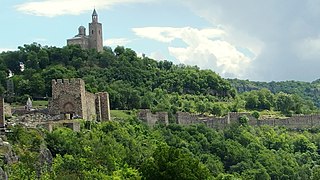
Tsarevets is a medieval stronghold located on a hill with the same name in Veliko Tarnovo in northern Bulgaria. Tsarevets is 206 metres (676 ft) above sea level. It served as the Second Bulgarian Empire's primary fortress and strongest bulwark between 1185 and 1393, housing the royal and the patriarchal palaces, and it is also a popular tourist attraction.
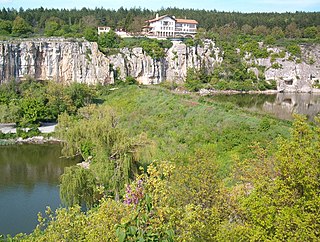
Kaylaka is a large park and protected area south of Pleven, Bulgaria, situated in a Karst valley. The park is spread over 10 km2 and is surrounded by sheer cliffs that suggest favourable conditions for rock climbing. The ruins of the Roman fortress of Storgosia are located in Kaylaka, as well as ponds and reservoirs with boats and pedalos, a swimming pool, hotels, cafés, restaurants, discothèques and playgrounds.
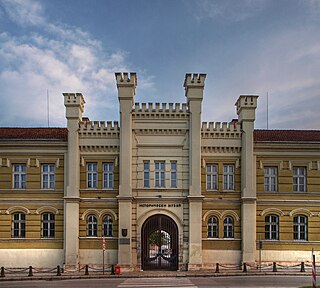
The Pleven Regional Historical Museum, founded in 1953, is one of the largest museums in Bulgaria. The museum is situated in a two-story edifice near the centre of Pleven that is a monument of culture of national importance and has an area of 7,000 m². Its main stock includes over 180,000 units and the museum library houses over 10,000 volumes of scientific literature and periodicals.

The stronghold of Cherven was one of the Second Bulgarian Empire's primary military, administrative, economic and cultural centres between the 12th and the 14th century. The ruins of the fortress are located near the village of the same name 30 to 35 kilometres south of Rousse, northeastern Bulgaria.
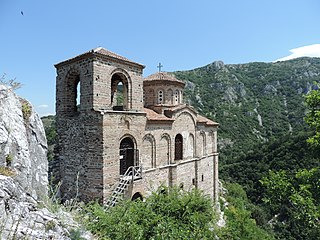
Asen's Fortress, identified by some researchers as Petrich (Петрич), is a medieval fortress in the Bulgarian Rhodope Mountains, 2 to 3 kilometres south of the town of Asenovgrad, on a high rocky ridge on the left bank of the Asenitsa River. Asen's Fortress is 279 metres (915 ft) above sea level.

Trilj is a municipality and town in inland Dalmatia, Croatia. It is located northeast of Split.

Deva Victrix, or simply Deva, was a legionary fortress and town in the Roman province of Britannia on the site of the modern city of Chester. The fortress was built by the Legio II Adiutrix in the 70s AD as the Roman army advanced north against the Brigantes, and rebuilt completely over the next few decades by the Legio XX Valeria Victrix. In the early 3rd century the fortress was again rebuilt. The legion probably remained at the fortress until the late 4th or early 5th century, upon which it fell into disuse.
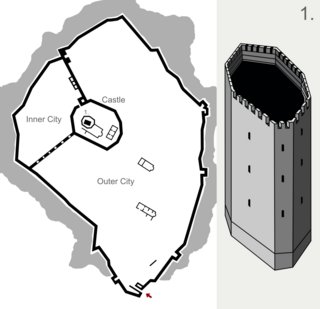
Tsepina or Tzepaina was a castle and town in the western Rhodope mountains, southern Bulgaria, now in ruins. It is 6 kilometres (4 mi) from the Dorkovo village in the north-eastern part of the Chepino Valley. Tsepina is 317 metres (1,040 ft) above sea level.

Grivitsa is a village in Pleven Municipality, Pleven Province, central northern Bulgaria. It is primarily known as the site of one of the key engagements in the Siege of Plevna during the Russo-Turkish War of 1877–1878.
Iskar is a town in central northern Bulgaria, part of Pleven Province. It is the administrative centre of Iskar Municipality, which lies in the western part of the Province. The town of Iskar is located in the central Danubian Plain, near the Iskar River, 18 kilometres from Knezha and 32 kilometres from the provincial capital of Pleven. As of December 2009, the town has a population of 3,622 inhabitants.
Krasen or Krasen Kale is a Bulgarian fortress near the village of Bata in the Pazardzhik Province. It is about 3 kilometres (2 mi) from the village and 6 kilometres (4 mi) south of the municipal center, Panagyurishte.

The Palace of Omurtag or Aul (Aulē) of Omurtag is an archaeological site in northeastern Bulgaria dating to Late Antiquity and the Early Middle Ages located near the village of Han Krum in Shumen Province. The site has been pinpointed as the location of a fort and palace of Omurtag, ruler (kanasybigi) of the First Bulgarian Empire in 815–831, as mentioned in the Chatalar Inscription of 822. Earlier structures in the vicinity of the fortress have been identified as the Arian episcopal see of a Gothic bishop.
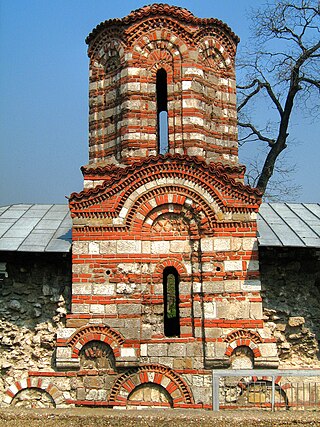
The Church of Saints Peter and Paul is a partially preserved medieval Eastern Orthodox church in the town of Nikopol, which lies in north central Bulgaria on the south bank of the Danube and is administratively part of Pleven Province. The church was built in the 13th or 14th century and was decorated with brick and marble patterns. The west part of the church is entirely in ruins.
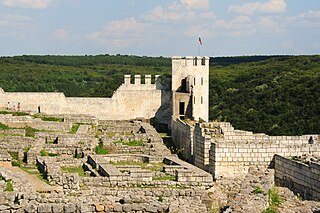
The Shumen Fortress is an archaeological site overlooking the city of Shumen in north-eastern Bulgaria.



















